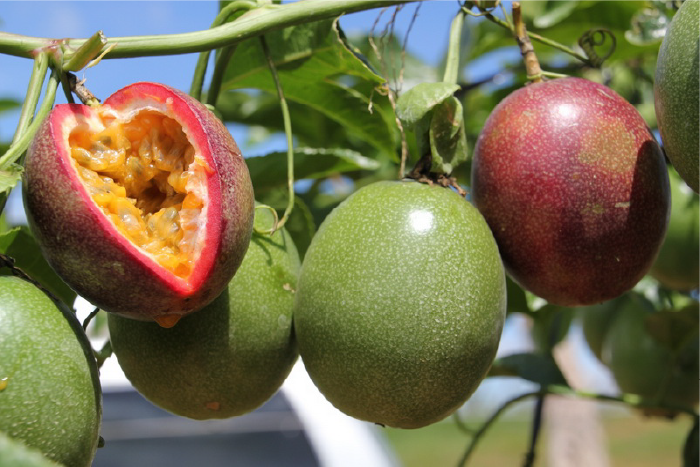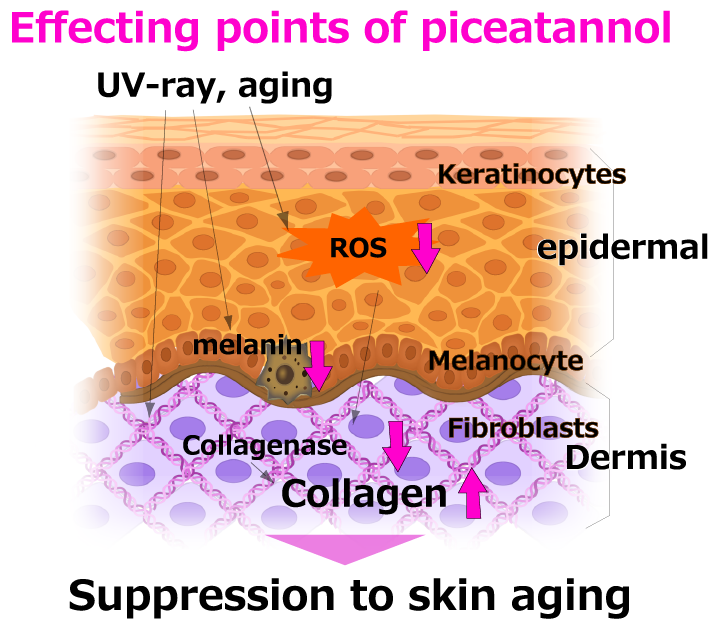Health Functionality Research and Development
Passienol™
1. What is Passienol™
Passienol™ is a passion fruit seed extract (passion fruit seed polyphenol), which was developed by MORINAGA & CO., LTD. as a result of extensive research into food ingredients. It is rich in the polyphenol piceatannol and its dimer, scirpusin B. MORINAGA & CO., LTD. was the first company in the world to develop a passion fruit seed extract, which is the result of extensive research into food ingredients. MORINAGA & CO., LTD. was the first company in the world to discover that passion fruit seeds are rich in piceatannol (see below), and succeeded in extracting piceatannol in high concentrations. MORINAGA & CO., LTD. named this new extract “Passienol” to express the hope that it will be useful for your health.
Y. Matsui et. al., J. Agric. Food Chem. 58, 11112 (2020)
K. Sasaki et. al., Journal of Tohoku Pharmaceutical University 57, 61 (2010)
Thi Ngoc Ha Lai,et. al., Food Chemistry 138, 1421 (2013)
Ting Xiang, et. al., Chem. Pharm. Bull. 53, 1204 (2005)
B. Benova et. al., J. Sep. Sci. 31, 2404 (2008)
Li-Lian L., et. al., J Chromatogr B Analyt Technol Biomed Life Sci. 853, 175 (2007)
Emma C. et. al., J Agric Food Chem. 51, 1208 (2003)
Agnes M. et. al., J. Agric. Food. Chem. 52, 4713 (2004
2. What is passion fruit?
Passion fruit is native to South America and is represented by the Passionfruit (Passiflora edulis). The fruit is slightly oval in shape with a diameter of 5 to 8 cm. The thick rind is filled with clusters of orange-yellow transparent jelly-like flesh surrounding a black seed, as shown in the photo at right. It has a tropical sweet and sour taste and a distinctive, refreshing fragrance. In Japan, it can be found in Kagoshima and Okinawa.

Passion fruit can be halved and the flesh eaten with the seeds intact. The seeds crack easily when chewed and the texture of the seeds is delightful. In addition to being eaten as a fresh fruit, the juice or concentrated puree is widely used in juices, candies and jams around the world. The oil obtained from the seeds is used in cosmetics and other products.
Passion fruit also contains niacin, folic acid, vitamin C, citric acid, potassium and beta-carotene, which are said to have various effects such as preventing high blood pressure, dilating blood vessels, preventing anemia and relieving fatigue.
3. Sirtuin genes activation by piceatannol
The main ingredient in Passienol™, piceatannol, is very similar in structure to resveratrol, which has been touted as an anti-aging ingredient, as shown in the figure to the right. Scirupsin B is composed of two piceatannols and has powerful antioxidant activity.
Resveratrol is found in red wine and grapes, and is said to contribute to the activation of sirtuins, a type of deacetylase that has been noted as a factor in longevity, as well as the French Paradox (the French have a high rate of smoking and a relatively low incidence of coronary heart disease despite a diet high in saturated fatty acids).
Sirtuins, in particular, are activated by calorie restriction and are known to exhibit anti-aging effects by improving various diseases, as shown below. Since it has been verified in various species, including mammals, that calorie restriction has a life-extension effect, it is thought that activating sirtuins can be expected to have anti-aging and life-extension effects without calorie restriction.

MORINAGA & CO., LTD. believes that piceatannol may have superior effects to resveratrol in physiological functions, and we are actively conducting basic and applied research on piceatannol and its dimer, Scirupsin B, contained in Passienol™ as an anti-aging ingredient.
4. The Anti-Aging Benefits of Passeinol™
effects on blood vessels
Arterial vessels must dilate and constrict flexibly to maintain smooth blood flow. However, aging and poor dietary habits can harden the blood vessels and cause cardiovascular diseases such as atherosclerosis and ischemic heart disease. NO (nitric oxide) is known to have a dilating and protective effect on blood vessels.
Resveratrol has been reported to be protective against cardiovascular disease. Therefore, we investigated the effects of Passienol™ and its main components, piceatannol or scirupsin B, on blood vessels.

(1) Vasodilation by NO production (ex vivo)
The effects of Passienol™, piceatannol or Scirupsin B on blood vessels in rats were evaluated. As a result, the blood vessels were dilated by Passienol™, piceatannol, or Scirupsin B. The results showed that the vessels were dilated by Passienol™, piceatannol, or Scirupsin B. Further studies showed that they acted on vascular endothelial cells and caused them to dilate by promoting NO (nitric oxide) production. Passienol™, piceatannol or Scirupsin B may be expected to prevent cardiovascular disease because of their NO-mediated vasodilatation.
(2) Enhancement of eNOS (in vitro) :
Resveratrol is known to promote the expression of endothelial nitric oxide synthase (eNOS), a NO-producing enzyme, in endothelial cells. Therefore, we investigated the effect of piceatannol, the main component of Passienol™, on eNOS expression. In vascular endothelial cells, piceatannol increased the expression of eNOS and phosphorylated eNOS (the active form of eNOS). Its effect was also found to be stronger than that of resveratrol. Since the decline in vascular function with aging is known to be related to the decline in eNOS function, piceatannol may have a stronger effect on vascular function than resveratrol.
5. Antioxidant enhancement effect of piceatannol in vitro
In our bodies, which use oxygen to produce energy, reactive oxygen species are produced at the same time as we use oxygen. In particular, muscles produce reactive oxygen species (ROS) during muscle contraction, and the amount of ROS in muscle cells rises due to prolonged or repetitive muscle contraction and the decline in antioxidant capacity with age; persistently high ROS levels can lead to muscle fatigue, muscle atrophy, and other disorders, as well as a decline in athletic performance, which can lead to a decline in quality of life. Therefore, the antioxidant capacity of piceatannol was evaluated in mouse myotube cells (C2C12 cells).
The results showed that piceatannol increased the gene expression of HO-1 (heme oxygenase-1) and SOD1 (superoxide dismutase 1), which are antioxidant enzymes in vitro, in a concentration-dependent manner. In particular, the HO-1 induction effect of piceatannol was significantly higher than that of other polyphenols with antioxidant activity. Furthermore, when hydrogen peroxide (H2O2) was applied to myotubular cells of mice and the amount of ROS generation was measured by fluorescence intensity, the production of ROS was significantly suppressed by the prior addition of piceatannol.
These results suggest that piceatannol may increase the expression of antioxidant enzymes in vitro and exert an antioxidant effect in muscle cells to prevent muscle fatigue and reduced exercise capacity.
6. The effect of Passienol™ on skin moisture and elasticity
The effectiveness of a drink containing Pasenol™ was tested on 19 healthy men and women aged 30-60 years who were concerned about their skin health.
Passienol™ is a passion fruit seed extract rich in piceatannol, a type of polyphenol, which is the active ingredient in the drink. The effects on skin moisture content, transepidermal water evaporation (TEWL), skin elasticity (R7), and pore shape were evaluated in a stratified, randomized, double-blind, placebo-controlled, parallel-group comparison of Passienol™ drinks containing 30 mg of Piceatannol per day for eight consecutive weeks. The results showed a significant increase in the amount of change in skin water content in the Passienol™ group compared to the piceatanol-free group at week 8.
The results showed a significant increase in the amount of change in skin water content in the Passienol™ group compared to the piceatannol-free placebo group at week 8. There was also no difference in TEWL between the groups, but only the Passienol™ group had a significant reduction in TEWL compared to the pre-intake level. Furthermore, R7, the percentage of elasticity at regression, increased significantly at week 8 in the Passienol™ group, compared to the placebo group, and the amount of change was significantly higher than that of the placebo group.
These results suggest that in healthy middle-aged and elderly men and women with dry skin (suffering from dryness), intake of Passienol™ has the potential to maintain skin moisture, preserve skin elasticity, and improve quality of life.
The skin is the outermost part of the body and is exposed to many stimuli. Changes in the skin, such as sun spots, wrinkles, and sagging due to UV rays and aging, play a significant role in the appearance of age. The anti-aging effects of Piceatannol or Scirupsin B, the main ingredient of Passienol™, on the skin were studied in melanocytes (pigment cells), fibroblasts, and keratinocytes, respectively.

(1) Effect on melanocytes
The effects of piceatannol, the main ingredient in Passienol™, on melanin production were studied. In melanin-producing cells, piceatannol decreased melanin synthesis in a concentration-dependent manner and its effect was stronger than that of resveratrol. Melanin is mainly produced by UV stimulation and is the cause of skin blemishes. It has been shown that piceatannol may inhibit the formation of melanin by inhibiting its synthesis.
(2) Effects on fibroblasts
The effect of piceatannol, the main ingredient in Passienol™, on collagen production in the dermis was studied. In dermal fibroblasts, piceatannol increased collagen production in a concentration-dependent manner and was found to be more effective than resveratrol. Collagen, which gives the skin its elasticity and firmness in the dermal layer, is known to decline with age. Piceatannol may promote collagen production and thus reduce sagging, wrinkles, and other forms of aging in the skin.
(3) Effects on keratinocytes
The effects of piceatannol and scirpsin B, the main components of Passienol™, on keratinocytes on the skin surface were studied. In keratinocytes, piceatannol and scirupsin B increased the amount of the antioxidant glutathione (glutathione, GSH). In addition, the elevated ROS caused by UV stimulation were inhibited by piceatannol. Next, the effect of keratinocytes on fibroblasts was examined. When fibroblasts were cultured in keratinocyte culture medium after UV stimulation, the collagen-degrading enzyme activity of the fibroblasts increased, whereas the collagen-degrading enzyme activity of the fibroblasts was inhibited by the application of piceatannol to the keratinocytes. Piceatannol inhibited UV-stimulated reactive oxygen species and indirectly suppressed collagen degradation in fibroblasts, indicating the potential to reduce sagging skin and wrinkles caused by photoaging.
